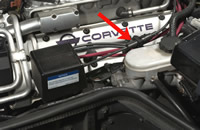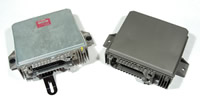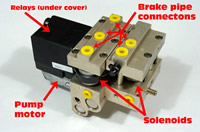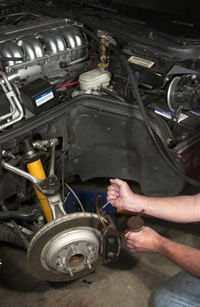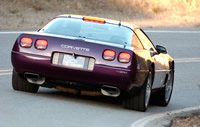Stop to Match the Go - All About 1986 - 1996 C4 Corvette Antilock Brake and Traction Control Systems - Page 3 of 3
© 2009 by Hib Halverson
No use without permission, All Rights Reserved
Parts Sources
With the first of the C4 antilock systems now 21 years old, we're happy to report that their major components are, generally, quite reliable. If an EBCM or EBTCM fails, it's usually due to negligence or abuse such as: water damage or voltage spikes caused by incorrect jumper cable connections, grounding of the battery or use of a charger/booster to start the car. Another threat to EBCMs, or any on-board electronics for that matter, is welding anything-a roll bar/cage, exhaust hangers and brackets, suspension modifications or whatever-to the car's structure. Welding causes damaging voltage spikes in the car's electronics, the extent of which depends on where a welding ground is attached. Welding can fry an ABS controller even with both battery cables disconnected. To be safe-especially, considering the cost of ABS controllers and that some are no longer available-disconnect the ABS/TCS wiring harness from EBCM or EBTCM before welding. New modules for MY90-'96 are available from GM Parts sources such as Corvette specialist, Tom Henry Racing. Remanufactured units are available from NAPA stores or its web site, www.napaonline.com. NAPA remanufactures the '86-'89, '90-'91 and '92-'94/'95 ZR-1 controllers but, as yet, not the '95 base/'96 unit. Prices start at about $500 for remanufactured controllers and go to $1500 for new units. Other system electronics, such as relays, wheel sensors, wires and connectors, are a little more likely to experience trouble, but are still pretty reliable and can be purchased from GM Parts sources or the aftermarket. The lateral acceleration switch ('86-'89) or accelerometer ('90-'93 and '94-'96) occasionally fail and all these have been discontinued by GM. The only sources for these parts are new-old-stock at Chevrolet dealers or serviceable used pieces from Corvette parts recyclers or salvage yards.
Brake pressure modulators have excellent long-term durability provided the brake fluid gets flushed occasionally. If you have to replace a BPM, new '92-'94/'95 ZR-1 units can be had from GM Parts sources, however, new '86-'91 and '95/base-'96 units have been discontinued by GM. BPM's are not field-serviceable, but NAPA currently remanufactures the '86-'91 and the '95 base/'96 unit. NAPA plans to add a remanufactured '92-'94/'95 ZR-1 BPM. Prices for BPMs range from 500-1000 bucks for reman and go well over a thousand for new units.
Considering those prices, it's wise to enhance BPM life with the following procedures. First: when you change brake pads, never push brake caliper pistons back without opening the caliper bleed screws. Failing to do that forces old brake fluid to back-flow through the BPM. That fluid will be contaminated with dirt, corrosion or moisture and, because fluid back flow is not filtered, contamination could lodge in a solenoid valve and, eventually, cause the valve to stick. The solenoid valves are normally-open, however after an ABS application, in the very rare case a valve sticks in the pressure hold or decrease positions, base brake system performance may degrade. The symptoms would be the service light on and the brakes pulling to one side.
Secondly, we suggest you flush your brake system, per the Service Manual, every two years. Occasional flushes keep the contaminant level low and ABS operating properly, as well as improving base brake system durability. At minimum, use a brake fluid that meets the DOT-3 specification. If you drive your car hard, use a premium brake fluid which meets DOT-4 or DOT-5.1 such as Motul "DOT5.1" fluid. Do not use silicone-based fluids which meet DOT-5.0. They are not compatible with antilock brake systems and will cause inconsistent and unsafe ABS operation.
What about "Why"
We've covered what makes up a C4's antilock braking system, when it works, how it works, what to do when it doesn't work, but we haven't talked much about why ABS is such a great feature. Recall that a tire generates maximum braking traction when it exhibits negative slip but is not fully-locked-up. Since ABS allows 99.5% of Corvette drivers to "threshold brake" more consistently, in an ABS-equipped car, you're going to be able to brake harder when driving aggressively. You're, also, going to be able to have maximum braking on surfaces with poor traction when, otherwise, threshold braking would be difficult if not impossible. Additionally, with a '92-'96's traction control, on slick surfaces, you're going to be less liable to get the rear wheels spinning.
A tire under optimum braking is still capable of significant lateral traction, whereas one that's locked-up is incapable of any "lat" at all. Since ABS can only control the brakes, it gives priority to cornering (lateral acceleration) first. Hence, you can still steer the car while in full antilock braking. In addition, the front wheels have antilock braking on an individual basis, allowing safe, controlled stops on "split-mu" surfaces were one tire is on a surface that is more slick than the other.
Bottom Line: In a panic stop, instead of the wheels locking and steering control being lost, ABS provides maximum braking while enabling the driver to maintain steering control and that, for most of us, is the greatest single advantage of antilock brakes!
Thanks: The following people contributed to this article: Chris Petris, technical writer and owner of the Corvette Clinic; David Fulcher, dealer service technician; Scott Allman, former Lead Engineer for Corvette ride and handling at GM and currently Principle Engineer, Vehicle Dynamics Group, Harley-Davidson Motor Company; Jack Gillies, Brake System Integration Engineer, GM High-Performance Vehicle Operations (now retired); Marc Haibeck at Haibeck Automotive Technology; Stan Lorence, Parts Department Manager at Tom Henry Chevrolet/Tom Henry Racing and Brad Thatcher, Service Program Manager, Performance Cars at GM. Lastly, this CAC article was adapted from a two-part series published in Corvette Enthusiast magazine in its November and December 2007 issues. The CAC would like to thank CE Editor, Andy Bolig, for his support in allowing us to repost this article.
For Your Information:
Bosch Diagnostics
2800 South 25th Avenue
Broadview, IL 60155
www.boschdiagnostics.com
Corvette Central
P.O. Box 16
Sawyer, MI 49125
800-345-4122
www.corvettecentral.com
EASE Diagnostics
Scott Technology Park
RR 1 Box 285
Olyphant, PA 18447
888.366.3273
www.obd2.com
Eastwood Co.
263 Shoemaker Rd.
Pottstown PA 19464
800.345.1178
www.eastwoodco.com
Fluke Corporation
PO Box 9090
Everett WA 98206
800-443-5853
www.flukeus.com
Motul USA
790-C Indigo Ct.
Pomona CA 91767
800.926.6685
NAPA
see your local NAPA retailer
www.napaonline.com
SPX Kent-Moore
28635 Mound Road
Warren MI 48092-3499
800-468-6657
Tom Henry Racing
Box 68
Bakerstown PA 15007
877-866-7278
www.tomhenryracing.com

